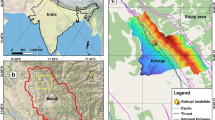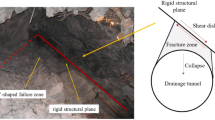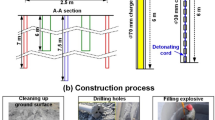Abstract
This paper discussed the changes in the movement trajectories and deposition patterns of the rock avalanches in the baffle-net structure under different cases, and obtained the optimal layout parameters of the baffle-net structure in terms of protection effect. The results showed that (1) the particles leaking from the gap between the baffle groups and flowing around the baffle sides were mainly concentrated in Regions I (0 ~ 34 cm) and II (34 ~ 68 cm) behind the baffles, and the movement range of such particles was relatively small, with low risk; while the splash particles of the rock avalanches were concentrated in Region IV (102 ~ 137 cm) behind the baffles, the movement range of such particles was far, with high risk; (2) when the flexible net structure of the first row of baffles was arranged, the blocking rate increased with the increase of the protective net coverage; when the coverage was 100% (case 7), the particle blocking rate behind the baffles reached 52.2%; (3) under the case of 100% coverage, we considered the multi-row baffle-netting, where the case 10 had the highest blocking rate, higher than cases 7, 8, and 9, and the case 10 had the least particle splashing, which was the optimal layout of the baffle-net structure.





















Similar content being viewed by others
Data availability
The data that support the findings of this study are available from the corresponding author, Dongpo Wang, upon reasonable request.
References
Bi YZ, He SM, Li XP (2016) Kinetic mechanism of mixed particles under constraint conditions[J]. Chin J Geotech Eng 38(3):529–536 (in Chinese)
Bi YZ, Du YJ, He SM et al (2018) Numerical analysis of effect of baffle configuration on impact force exerted from rock avalanches[J]. Landslides 15(5):1029–1043. https://doi.org/10.1007/s10346-018-0979-z)
Bi YZ, He SM, Du YJ et al (2019) Effects of the configuration of a baffle–avalanche wall system on rock avalanches in Tibet Zhangmu: discrete element analysis[J]. Bull Eng Geol Env 78(4):2267–2282. https://doi.org/10.1007/s10064-018-1284-8)
Bi YZ, Sun XP, Zhao HZ et al (2020) Comparison regarding the effects of different baffle systems as impacted by rock avalanches[J]. Int J Civil Eng 1–18. https://doi.org/10.1007/s40999-020-00557-w
Bi YZ, Wang XY, Wang DP et al (2023) A Methodological Study on the Design Defending Baffles Based on Mangrove Bionics[J]. Buildings 13(2):310. https://doi.org/10.3390/buildings13020310
Choi CE, Ng CWW, Song D et al (2014) Flume investigation of landslide debris–resisting baffles[J]. Can Geotech J 51(5):540–553
Choi CE, Ng CWW, Goodwin GR et al (2016) Flume investigation of the influence of rigid barrier deflector angle on dry granular overflow mechanisms[J]. Can Geotech J 53(10):1751–1759
Choi CE, Cui Y, Liu LHD et al (2017) Impact mechanisms of granular flow against curved barriers[J]. Géotechnique Lett 7(4):330–338
Choi CE, Ng CWW, Liu H et al (2020) Interaction between dry granular flow and rigid barrier with basal clearance: analytical and physical modelling[J]. Can Geotech J 57(2):236–245
Choi CE (2013) Flume and discrete element investigation of granular flow mechanisms and interaction with baffles[D]. The Hong Kong University of Science and Technology p 120–135
Cosenza E, Cozzolino L, Pianese D et al (2006) Concrete structures for mitigation of debris-flow hazard in the Montoro Inferiore Area, Southern Italy[C]. 2nd International Congress, IFSC, Naples, p 1–12
Cui P, Chen XQ, Zhu YY et al (2011) The Wenchuan earthquake (May 12, 2008), Sichuan province, China, and resulting geohazards[J]. Nat Hazards 56(1):19–36
Fei J, Jie Y, Sun X et al (2020a) Experimental investigation on granular flow past baffle piles and numerical simulation using a μ (I)-rheology-based approach[J]. Powder Technol 359:36–46
Fei JB, Jie YX, Hong CY et al (2020b) Modelling of avalanche-obstacle interaction using the depth-averaged continuum approach[J]. Granular Matter 22(2):1–15
Geertsema M, Bevington A (2021) A cautionary note for rock avalanche field investigation: recent sequential and overlapping landslides in British Columbia. Canadian Geotechnical Journal 58(5):737. https://doi.org/10.1139/cgj-2019-0751
Hákonardóttir KM, Jóhannesson T, Tiefenbacher F et al (2001) A laboratory study of the retarding effect of breaking mounds in 3, 6 and 9 m long chutes[M]. Veðurstofa Íslands, p 21–41
He T (2019) Research on characteristics and treatment of Qifenshui village debris flow in Guilin[D]. Guilin University of Technology (in Chinese), 40–51
Huang Y, Zhang B, Zhu C (2021) Computational assessment of baffle performance against rapid granular flows[J]. Landslides 18:485–501
Hungr O, Leroueil S, Picarelli L (2014) The Varnes classification of landslide types, an update[J]. Landslides 11:167–194
Kong Y, Li X, Zhao J (2021) Quantifying the transition of impact mechanisms of geophysical flows against flexible barrier[J]. Eng Geol 289:106188
Lei M, Yang P, Wang Y et al (2020) Numerical analyses of the influence of baffles on the dynamics of debris flow in a gully[J]. Arab J Geosci 13(19):1–15
Li X, Yan Q, Zhao S et al (2020) Investigation of influence of baffles on landslide debris mobility by 3D material point method[J]. Landslides 17:1129–1143
Lien HP (2003) Design of slit dams for controlling stony debris flows[J]. Int J Sedim Res 18(1):74–87
Liu C, Yu Z, Zhao S (2020) Quantifying the impact of a debris avalanche against a flexible barrier by coupled DEM-FEM analyses[J]. Landslides 17(1):33–47
Luo JY, Xu ZM, Ren Z et al (2020) Quantitative assessment of weathering degree of the Touzhai rock-avalanche deposit in Southwest China[J]. Geomorphology 359
Ng CWW, Choi CE, Kwan JSH et al (2014) Effects of baffle transverse blockage on landslide debris impedance[J]. Procedia Earth Planet Sci 9:3–13
Ng CWW, Choi CE, Song D et al (2015) Physical modeling of baffles influence on landslide debris mobility[J]. Landslides 12(1):1–18
Ng CWW, Liu H, Choi CE et al (2022) Effects of basal clearance on the impact dynamics of dry granular flow against dual rigid barriers[J]. Can Geotech J 99(999):1–14
Qi S, Xu Q, Zhang B et al (2011) Source characteristics of long runout rock avalanches triggered by the 2008 Wenchuan earthquake, China[J]. J Asian Earth Sci 40(4):896–906
Ran CY, He L, Yu XM et al (2016) Cause analysis and comprehensive post-disaster control of debris flow of Hanyuan Wangong landslide occurred on July 27[J]. Des Hydroelectric Power Station 32(1):10–19 (in Chinese)
Remaître A, Van Asch TWJ, Malet JP et al (2008) Influence of check dams on debris-flow run-out intensity[J]. Nat Hazard 8(6):1403–1416
Song D, Choi CE, Ng CWW et al (2018) Geophysical flows impacting a flexible barrier: effects of solid-fluid interaction[J]. Landslides 15:99–110
Teufelsbauer H, Wang Y, Pudasaini SP et al (2011) DEM simulation of impact force exerted by granular flow on rigid structures[J]. Acta Geotech 6(3):119–133
Thompson PL, Kilgore RT (2006) Hydraulic design of energy dissipators for culverts and channels: hydraulic engineering circular number 14[R]. National Highway Institute (US), p 74–86
Wang F, Chen X, Chen J et al (2017) Experimental study on a debris-flow drainage channel with different types of energy dissipation baffles[J]. Eng Geol 220:43–51
Wang D, Li Q, Bi Y et al (2020) Effects of new baffles system under the impact of rock avalanches[J]. Eng Geol 264:105261
Wang D, Bi Y, Li Q et al (2021) Kinetic response analysis of different types of baffle submitted to rock avalanches based on discrete element method[J]. Environ Earth Sci 80(17):1–21
Wanze Z, Haifeng H, Wei K et al (2018) Failure mode and optimization analysis of pile structure under the impact action of boulders in debris flow[J]. Sci Technol Eng 18(4):15–22 (in Chinese)
Wendeler C, Volkwein A, Roth A et al (2008) Hazard prevention using flexible multi-level debris flow barrier[C]. 11th Interpraevent Congress, Interpraevent, Dornbirn, Austria, p 547–554
Yang DX, Wang WG, Cheng XQ (2014) Steel pipe piles used for countermeasures in narrow-steep debris flow gullies: a case study of Xiaogangjian debris flow control[J]. J Mt Sci 32(1):74–80 (in Chinese)
Zanuttigh B, Lamberti A (2006) Experimental analysis of the impact of dry avalanches on structures and implication for debris flows[J]. J Hydraul Res 44(4):522–534
Zhang M, Yin Y (2013) Dynamics, mobility-controlling factors and transport mechanisms of rapid long-runout rock avalanches in China[J]. Eng Geol 167:37–58
Zhao T, Crosta GB, Dattola G et al (2018) Dynamic fragmentation of jointed rock blocks during rockslide-avalanches: insights from discrete element analyses[J]. J Geophys Res: Solid Earth 123(4):3250–3269
Zhu L, Liang H, He S et al (2020) Failure mechanism and dynamic processes of rock avalanche occurrence in Chengkun railway, China, on August 14, 2019[J]. Landslides 17(4):943–57
Zhuang Y, Xu Q, Xing A (2019) Numerical investigation of the air blast generated by the Wenjia valley rock avalanche in Mianzhu, Sichuan, China[J]. Landslides 16(12):2499–2508
Acknowledgements
The authors thank all anonymous reviewers for helpful suggestions.
Funding
This work was supported by the State Key Laboratory of Geohazard Prevention and Geoenvironment Protection Independent Research Project (SKLGP2021Z001), Sichuan Science and Technology Plan Project (2023YFS0444), National Key Research and Development program of China (Project No.2022YFF0800604), the Major Program of the National Natural Science Foundation of China (Grant No.42090051), and the National Natural Science Foundation of China (Grant No. 42207232).
Author information
Authors and Affiliations
Corresponding author
Rights and permissions
Springer Nature or its licensor (e.g. a society or other partner) holds exclusive rights to this article under a publishing agreement with the author(s) or other rightsholder(s); author self-archiving of the accepted manuscript version of this article is solely governed by the terms of such publishing agreement and applicable law.
About this article
Cite this article
Bi, YZ., Wang, DP., Yan, SX. et al. Research on the blocking effect of baffle-net structure on rock avalanches: consider the influence of particle splashing. Bull Eng Geol Environ 82, 277 (2023). https://doi.org/10.1007/s10064-023-03289-y
Received:
Accepted:
Published:
DOI: https://doi.org/10.1007/s10064-023-03289-y




